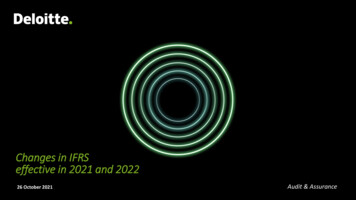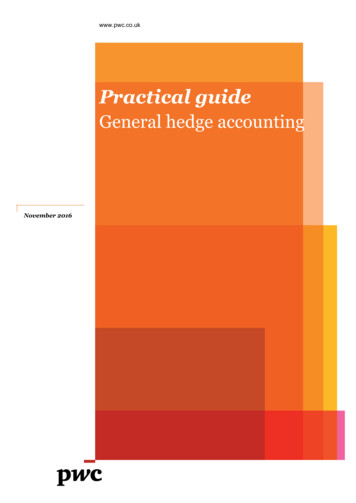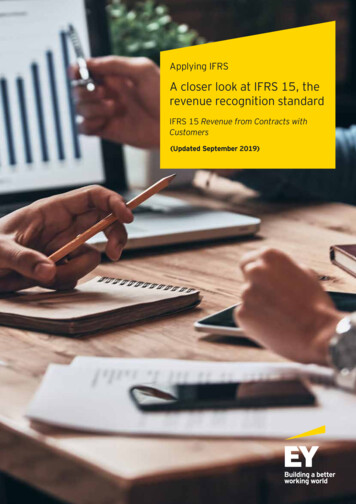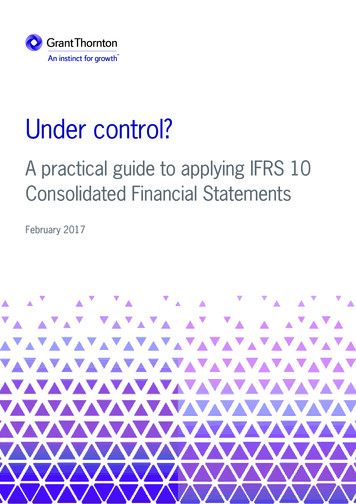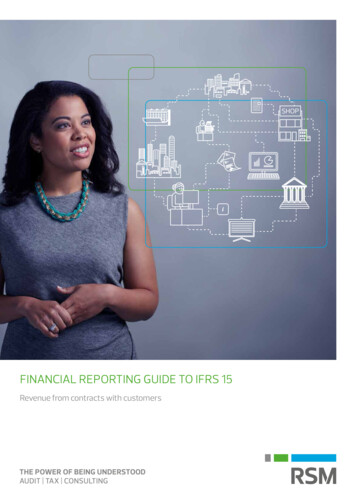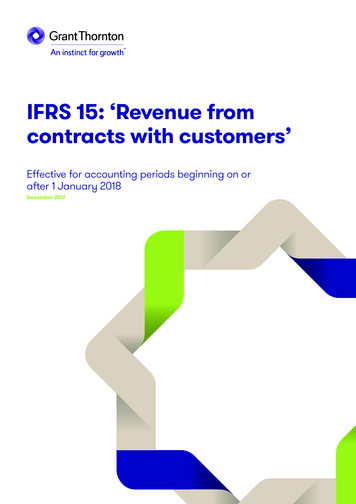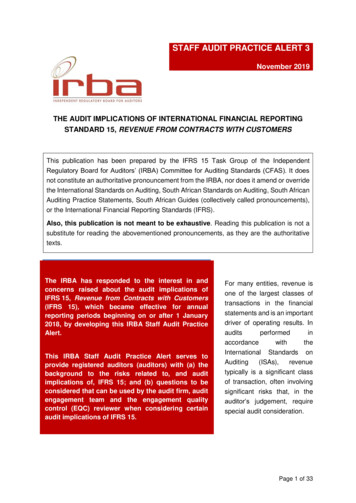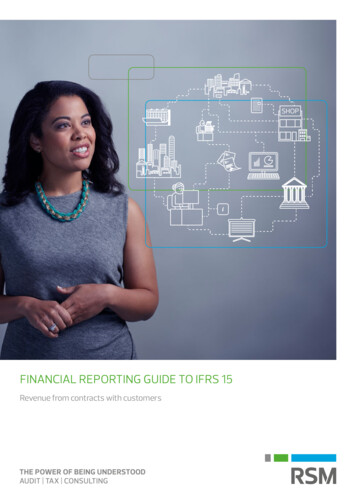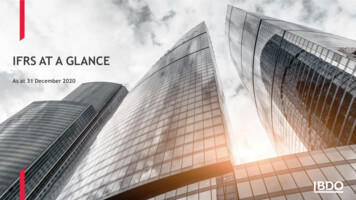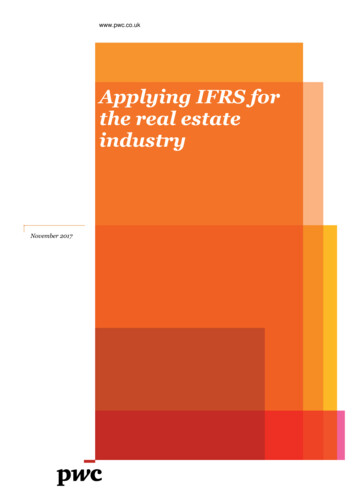
Transcription
www.pwc.co.ukApplying IFRS forthe real estateindustryNovember 2017
Applying IFRS for the real estate industryContentsIntroduction to applying IFRS for the real estate industry11.Real estate value chain21.1.Overview of the investment property industry21.2.Real estate life cycle21.3.Relevant accounting standards32.Acquisition and construction of real estate52.1.Overview52.2. Definition and classification52.3. Acquisition of investment properties: asset acquisition or businesscombination92.4. Asset acquisitions: Measurement at initial recognition152.5. Accounting for forward contracts and options to acquire real estate182.6. Special considerations: investment properties under construction202.7. Accounting for rental guarantees212.8. Development properties: accounting for the costs of construction233.Subsequent measurement of investment property273.1.Costs incurred after initial recognition273.2. Replacement of parts of investment property and subsequent expenditure283.3. Subsequent measurement: Cost model293.4. Impairment323.5. Subsequent measurement: Fair value model363.6. Fair value measurement of investment property: IFRS 13383.7. Change in use of assets: transfers into and out of investment property454.Rental income: accounting by lessors494.1.Overview of guidance494.2. Definition of a lease494.3. Rental income: Lessor accounting504.4. Premiums for properties in a prime location564.5. Surrender premiums564.6. Assumption of potential tenant’s existing lease574.7. Key money584.8. Letting fees584.9. Tenant deposits received594.10. Revenue from managing real estate property604.11. Lease modifications644.12. Revenue recognition: Surrender premium/break costs654.13. Tenant obligations to restore a property’s condition655.66Real estate structures and tax considerationsPwC Contents
Applying IFRS for the real estate industry5.1.Consolidation665.2. Joint arrangements725.3. Taxation766.Disposal of investment property836.1.Classification as held for sale under IFRS 5836.2. Sale of investment property837.Other reporting issues867.1.Functional and presentation currency867.2. Cash flow statement888.Disclosures918.1.Segment disclosures918.2. IFRS 13 disclosures968.3. Disclosure of fair value for properties accounted for using the cost model97PwC Contents
Applying IFRS for the real estate industryIntroduction to applying IFRSfor the real estate industryWhat is the focus of this publication?This publication considers the main accounting issues encountered by real estate entities and the practicesadopted in the industry under International Financial Reporting Standards (IFRS).Who should use this publication?This publication is intended for real estate entities that construct and manage real estate property. Activitiessuch as the construction of properties on behalf of third parties, and holding or developing propertiesprincipally for sale or otherwise own use, are not considered in this publication.This publication is intended for: audit committees, executives and financial managers in the real estate industry; investors and other users of real estate industry financial statements, so they can identify some of theaccounting practices adopted to reflect features unique to the industry; and accounting bodies, standard-setting agencies and governments throughout the world that are interested inaccounting and reporting practices and responsible for establishing financial reporting requirements.What is included?This publication covers issues that we believe are of financial reporting interest due to their particular relevanceto real estate entities and/or historical varying international practice.This publication has a number of sections designed to cover the main issues raised.This publication is based on the experience gained from the worldwide leadership position of PwC in theprovision of services to the real estate industry. This leadership enables PwC’s Real Estate Industry Group tomake recommendations and lead discussions on international standards and practice.We hope you find this publication helpful.PwC 1
Applying IFRS for the real estate industry1. Real estate value chain1.1. Overview of the investment property industryThe investment property or real estate industry comprises entities that hold real estate (land and buildings) toearn rentals and/or for capital appreciation.Real estate properties are usually held through a variety of structures that include listed and privately heldcorporations, investment funds, partnerships and trusts.1.2. Real estate life cycleThe life cycle of real estate that is accounted for as investment property typically includes the following stages:1Acquisition andconstruction ofreal estate2Leasing orsubleasing ofreal estate3Managementof real estate4Sale ordemolition ofreal estateStep 1: Acquisition and construction of real estateControl of real estate can be obtained through: direct acquisition of real estate; construction of real estate; or leasing of real estate, under either operating or finance leases.Entities normally perform strategic planning before the acquisition, construction or leasing, to assess thefeasibility of the project.Entities might incur costs attributable to the acquisition, construction or leasing of real estate, during this firststep of the cycle. Entities might also enter into financing arrangements to secure the liquidity required for theacquisition and construction of real estate.Step 2: Leasing or subleasing of real estateMost real estate entities primarily hold real estate for own use or for the purpose of earning rentals.For entities holding real estate for the purpose of earning rentals, lease agreements might contain a variety ofterms. The most common terms that will feature in all leases include matters such as the agreed lease term (andany options to extend that term), as well as the agreed rental payments due. Additional items that might featureinclude payments for maintenance services, insurance, property taxes and terms of lease incentives provided tothe tenant.Step 3: Management of real estateReal estate entities often provide management services to tenants who occupy the real estate that they hold, toensure that the property is in good condition and to preserve the value of the real estate. These services might beperformed by the real estate owners themselves, or they might be outsourced to other entities that are designed toprovide these services. Services might include maintenance of common areas, cleaning and security.Step 4: Sale or demolition of real estateReal estate entities might sell the real estate that they hold at the end of the life cycle to benefit from capitalappreciation. Alternatively, entities might proceed with demolition of the property, potentially with a view toconstruction of a new property.PwC 2
Applying IFRS for the real estate industry1.3. Relevant accounting standardsAcquisition and construction of real estate that is accounted for as investment property is governed by therequirements of IAS 40, ‘Investment property’, IAS 16, ‘Property, plant and equipment’, and IAS 23,‘Borrowing costs’.The requirements of IAS 17, ‘Leases’, apply when an entity leases out the real estate property or an entity doesnot elect to classify its property interest under an operating lease as investment property. The requirements ofIAS 18, ‘Revenue’, apply for revenue generated by a real estate entity other than lease income.This publication is based on accounting standards that are effective for periods beginning on or after1 January 2017.There are a number of new standards, interpretations or amendments to existing standards issued as of thedate of this publication that are not yet effective. Their impact is presented in separate sections under eachrelevant area or otherwise referred to specifically in the guide. The standards, interpretations or amendmentsare as follows: IFRS 9, ‘Financial Instruments’, which replaces guidance of IAS 39 on classification and measurement offinancial instruments (‘IFRS 9’); IFRS 15, ‘Revenue from contracts with customers’, which replaces the guidance in IAS 18, IAS 11, IFRIC 13,IFRIC 15, IFRIC 18 and SIC 31 (‘IFRS 15’); IFRS 16, ‘Leases’, which replaces IAS 17, IFRIC 4, SIC 15 and SIC 27 (‘IFRS 16’); ‘Transfers of investment property’ amendments to IAS 40, ‘Investment Property’; IFRIC 22, ‘Foreign currency transactions and advance consideration’ (‘IFRIC 22’); and IFRIC 23, ‘Uncertainty over income tax treatments’ (‘IFRIC 23’).The following standards, effective as at the date of this publication, are referred to in the guide: IFRS 3, ‘Business combinations’ (‘IFRS 3’); IFRS 5, ‘Non-current assets held for sale and discontinued operations’ (‘IFRS 5’); IFRS 7, ‘Financial instruments: disclosures’ (‘IFRS 7’); IFRS 8, ‘Operating segments’ (‘IFRS 8’); IFRS 10, ‘Consolidated financial statements’ (‘IFRS 10’); IFRS 11, ‘Joint arrangements’ (‘IFRS 11’); IFRS 13, ‘Fair value measurement’ (‘IFRS 13’); IAS 1, ‘Presentation of financial statements’ (‘IAS 1’); IAS 2, ‘Inventories’ (‘IAS 2’); IAS 7, ‘Statement of cash flows’ (‘IAS 7’); IAS 8, ‘Accounting policies, changes in accounting estimates and errors’ (‘IAS 8’); IAS 11, ‘Construction contracts’ (‘IAS 11’); IAS 12, ‘Income taxes’ (‘IAS 12’); IAS 16, ‘Property, plant and equipment’ (‘IAS 16’); IAS 17, ‘Leases’ (‘IAS 17’); IAS 18, ‘Revenue’ (‘IAS 18’); IAS 21, ‘The effects of changes in foreign exchange rates’ (‘IAS 21’); IAS 23, ‘Borrowing costs’ (‘IAS 23’);PwC 3
Applying IFRS for the real estate industry IAS 27, ‘Separate financial statements’ (‘IAS 27’); IAS 28, ‘Investments in associates and joint ventures’ (‘IAS 28’); IAS 36, ‘Impairment of assets’ (‘IAS 36’); IAS 37, ‘Provisions, contingent liabilities and contingent assets’ (‘IAS 37’); IAS 38, ‘Intangible assets’ (‘IAS 38’); IAS 39, ‘Financial instruments: recognition and measurement’ (‘IAS 39’); IAS 40, ‘Investment property’ (‘IAS 40’); IFRIC 4, ‘Determining whether an arrangement contains a lease’ (‘IFRIC 4’); IFRIC 13, ‘Customer loyalty programmes’ (‘IFRIC 13’); IFRIC 15, ‘Agreements for construction of real estate’ (‘IFRIC 15’); IFRIC 18, ‘Transfers of assets to customers’ (‘IFRIC 18’); SIC 27, ‘Evaluating the substance of transactions involving the legal form of a lease’ (‘SIC 27’); and SIC 31, ‘Revenue – barter transactions involving advertising services’ (‘SIC 31’).PwC 4
Applying IFRS for the real estate industry2. Acquisition and constructionof real estate2.1. OverviewReal estate entities obtain real estate either by acquiring, constructing or leasing property. Property used for thepurpose of earning rentals is classified as investment property under IAS 40.2.2. Definition and classificationPrinciplesIAS 40 defines investment property as property that is held to earn rentals or capital appreciation or both.[IAS 40 para 5]. The property might be land or a building (part of a building) or both.Investment property does not include: Property intended for sale in the ordinary course of business or for development and resale. Owner-occupied property, including property held for such use or for redevelopment prior to such use. Property occupied by employees. Owner-occupied property awaiting disposal. Property that is leased to another entity under a finance lease.[IAS 40 para 9].Owner-occupied property is property that is used in the production or supply of goods or services or foradministrative purposes. [IAS 40 para 5]. A factory or the corporate headquarters of an entity would qualify asowner-occupied property. During the life cycle of a property, real estate entities might choose to redevelopproperty for the purposes of onward sale. Property held for sale in the ordinary course of business is classifiedas inventory rather than investment property. [IAS 40 para 9(a)]. Transfers between investment property andboth owner-occupied property and inventory are dealt with in section 3.7.Classification as investment property is not always straightforward. Factors to consider, when determining theclassification of a property, include but are not limited to: the extent of ancillary services provided (see section 2.2.2); the extent of use of the property in running an underlying business; whether the property has dual use (see section 2.2.6); the strategic plans of the entity for the property; and previous use of the property.PwC 5
Applying IFRS for the real estate industryExample – Property leased out to hotel management entityBackgroundEntity A owns property which it leases out under an operating lease to a hotel management entity. Entity Ahas no involvement in the running of the hotel or any decisions made; these decisions are all undertaken bythe hotel management entity.Does the property meet the definition of ‘investment property’ for entity A?SolutionYes. Although the property is used as a hotel by the lessee, entity A uses the property to earn rentals, and sothe property meets the definition of ‘investment property’.Where an entity decides to dispose of an investment property without development, it continues to treat theproperty as an investment property. [IAS 40 para 58]. The property will continue to be classified as investmentproperty until it meets the criteria to be classified as a non-current asset held for sale in accordance with IFRS 5(see section 6).Ancillary servicesWhere an entity provides insignificant ancillary services, such as maintenance, to the third party occupants ofthe property, this does not affect the classification of the property as an investment property. [IAS 40 para 11].Where ancillary services provided are more than insignificant, the property is regarded as owner-occupied,because it is being used to a significant extent for the supply of goods and services. For example, in a hotel,significant ancillary services such as a restaurant, fitness facilities or spa are often provided. IAS 40 provides noapplication guidance as to what ‘insignificant’ means. Accordingly, entities should consider both qualitative andquantitative factors in determining whether services are insignificant.Example – Serviced apartmentsBackgroundAn entity owns a number of apartments which it leases out to tenants under short-term leases. The entity isalso responsible for providing in-house cleaning services, and it undertakes to provide internet, telephoneand cable television to the tenants for an additional monthly fee. The additional fee charged for the services isapproximately 20% of the monthly rental.Does the property meet the definition of ‘investment property’?SolutionNo. The entity provides ancillary services to the tenants other than the right to use the property. The value ofthese services represents around 20% of the rental income. Therefore, these services cannot be viewed asinsignificant. The property is classified as property, plant and equipment in the financial statements ofthe entity.Properties under construction or developmentReal estate that meets the definition of ‘investment property’ is accounted for in accordance with IAS 40, evenduring the period when it is under construction. Further, an investment property under redevelopment forcontinued future use as investment property also continues to be recognised as investment property.Properties held to be leased out as investment propertyReal estate entities might hold investment properties that are vacant for a period of time. Where theseproperties are held to be leased out under an operating lease, they are classified as investment property.PwC 6
Applying IFRS for the real estate industryProperties with undetermined useLand with undetermined use is accounted for as investment property. This is due to the fact that an entity’sdecision around how it might use that land (be it as an investment property, inventory or as owner-occupiedproperty) is, of itself, an investment decision. In turn, the most appropriate classification for such property is asinvestment property. [IAS 40 para B67 (b) (ii)].Properties with dual useA property might be partially owner-occupied, with the rest being held for rental income or capital appreciation.If each of these portions can be sold separately (or separately leased out under a finance lease), the entityshould account for the portions separately. [IAS 40 para 10]. That is, the portion that is owner-occupied isaccounted for under IAS 16, and the portion that is held for rental income or capital appreciation, or both, istreated as investment property under IAS 40.If the portions cannot be sold or leased out separately under a finance lease, the property is investment propertyonly if an insignificant portion is owner-occupied, in which case the entire property is accounted for asinvestment property. If more than an insignificant portion is owner-occupied, the entire property is accountedfor as property, plant and equipment. There is no guidance under the standards as to what ‘insignificant’means; accordingly, entities should consider both qualitative and quantitative factors in determining whetherthe portion of the property is insignificant.Example – Hotel resort with a casinoBackgroundEntity A owns a hotel resort which includes a casino, housed in a separate building.The entity operates the hotel and other facilities on the hotel resort, with the exception of the casino, whichcan be sold or leased out under a finance lease. The casino is leased to an independent operator. Entity A hasno further involvement in the casino. The casino operator will only operate the casino with the existence ofthe hotel and other facilities.Does the casino meet the definition of ‘investment property’?SolutionYes. Management should classify the casino as investment property. The casino can be sold separately orleased out under a finance lease. The hotel and other facilities would be classified as property, plant andequipment.If the casino could not be sold or leased out separately on a finance lease, the whole property would betreated as property, plant and equipment.Group situationsWithin a group of entities, one group entity might lease property to another group entity for its occupation anduse. In the consolidated financial statements, such property is not treated as investment property, because fromthe group's point of view the property is owner-occupied. In the separate financial statements of the entity thatowns the property or holds it under a finance lease, the property will be treated as investment property if itmeets the definition. [IAS 40 para 15].In contrast, property owned or held under a finance lease by a group entity and leased to an associate or a jointventure should be accounted for as investment property in both the consolidated financial statements and anyseparate financial statements prepared. Associates and joint ventures are not considered part of the group forconsolidation purposes.PwC 7
Applying IFRS for the real estate industryProperties held under operating leasesAn entity might choose to treat a property interest that is held by a lessee under an operating lease as aninvestment property if: the rest of the definition of investment property is met (see section 2.2); and the lessee uses the fair value model in IAS 40 (see section 3.5).This choice is available on a property-by-property basis. The initial cost of a property interest held under anoperating lease and classified as an investment property is as prescribed for a finance lease (that is, an assetshould be recognised at the lower of the fair value of the property and the present value of the minimum leasepayments). [IAS 40 para 25].Impact of IFRS 16IFRS 16 brings almost all leases on the balance sheet of the lessee. The lessee recognises a right-of-use asset anda corresponding liability at the lease commencement date. [IFRS 16 para 22].As a result, under IFRS 16, property currently held under operating leases will be recognised on the balancesheet. If this property meets the definition of investment property, it is initially recognised in accordance withIFRS 16, and it is subsequently accounted for as investment property in accordance with IAS 40.The right-of-use asset might subsequently be carried at cost or fair value, depending on the accounting policy ofthe entity for investment properties.Example – Recognition of property held under an operating lease as investment propertyBackgroundAn entity owns a hotel that it leases out (as lessor) under an operating lease to a hotel management group.The hotel is situated on land leased by the government to the entity (as lessee) for a period of 99 years, withno transfer of title to the entity at the end of the lease. The hotel building’s useful life is expected to beapproximately 40 years. There are no provisions in the lease to return the land with the building intact at theend of the 99-year lease. At inception of the lease, the present value of the minimum lease payments issignificantly lower than the fair value of the land. On considering the lease classification guidance in IAS 17,it has been determined that the land lease meets the definition of an ‘operating lease’.Can the hotel be classified as investment property?SolutionBuilding:Yes. The building meets the definition of ‘investment property’ and should be accounted for under IAS 40.Land:The land meets the definition of ‘investment property’ and is recognised on the balance sheet as aninvestment property only if the entity has chosen the fair value model for investment property. [IAS40 para 6]. Otherwise, it is recognised and accounted for as operating lease under IAS 17.Impact of IFRS 16Under IFRS 16, the entity will need to recognise a right-of-use asset relating to the leased land.The right-of-use asset relating to the leased land should be accounted for as investment property, given thatit meets the definition. The policy that the entity applies for subsequent measurement of investment propertywill not affect the classification of the land as investment property.PwC 8
Applying IFRS for the real estate industry2.3. Acquisition of investment properties: asset acquisition orbusiness combinationEntities might acquire investment properties that meet the definition of an asset or investment properties,together with processes and outputs that meet the definition of a business under IFRS 3.It is also common in the real estate industry to structure property acquisitions and disposals in a tax-efficientmanner. This often involves the transfer of a company, frequently referred to as a ‘corporate wrapper’, whichholds one or more properties.The accounting treatment for an acquisition depends on whether it is a business combination or an assetacquisition.A ‘business’ is defined as an “integrated set of activities and assets that is capable of being conducted andmanaged for the purpose of providing a return in the form of dividends, lower costs or other economicbenefits directly to investors or other owners, members or participants”. [IFRS 3 App A].The legal form of the acquisition is not a determining factor when assessing whether a transaction is a businesscombination or an asset acquisition. For example, the acquisition of a single vacant investment property is not abusiness combination simply because it is effected using a corporate wrapper. Similarly, a transaction is not anasset acquisition simply because the acquiring entity purchases a series of assets rather than a company.A transaction will qualify as a business combination only where the assets purchased constitute a business.Significant judgement is required in the determination of whether the definition of a business is met.A business is a group of assets that includes inputs, outputs and processes that are capable of being managedtogether for providing a return to investors or other economic benefits. Not all of the elements need to bepresent for the group of assets to be considered a business: Outputs are not required for an integrated set to qualify as a business. [IFRS 3 para B10]. A business need not include all of the inputs or processes that the seller used in operating that business ifmarket participants are capable of acquiring the business and continuing to produce outputs (for example,by integrating the business with their own inputs and processes). [IFRS 3 para B8].Different properties might fall on a spectrum ranging from asset acquisition to business combination,depending on the facts and circumstances involved in the transaction. At one end of the spectrum is theacquisition of a vacant parcel of land; at the other end is the acquisition of a full service, fully operationalshopping mall.The purchase of a vacant parcel of land is typically viewed as an asset acquisition, because the land itself is aninput, but there are no significant processes in place. The acquisition of the full service shopping mall istypically viewed as a business combination, because the shopping mall has inputs (the building), processes (thestrategic management, employees and procedures currently operating) and outputs (store rentals).All other acquisitions fall somewhere in between these two on the spectrum. There is no bright line thatindicates whether the acquisition is that of a business or an asset. Each acquisition will be unique, and the factsand circumstances of each will have to be examined, with significant judgement being required.Each property type has its own considerations as to how it is operated and managed. In general, the moreactively managed a property is, the more likely it is to be considered a business.PwC 9
Applying IFRS for the real estate industryThe following diagram summarises the requirements of IFRS 3:Step 1: Identifythe element ofthe acquiredgroupInput:What did the acquirer buy?Output:What did the acquirer get, and want toget, out of this acquisition?Process:Are there any existing processestransferred to produce the output?NoYesStep 2: Assesscapability of thegroup to produceoutputsAre there sufficient inputs andprocesses to produce outputs?YesNoNoWhat are the missing inputs and/orprocesses to produce/achieve theoutputs?BusinessStep 3: Assessmarket participant’sability to produceoutputsYesProcess: are there any inherentprocesses attached to the inputs?AssetsAre market participants capable ofcontinuing to produce outputs?YesNoBusinessAssetsInputs and outputs alone (for example, the acquisition of a single-tenant property) would not lead to a businesscombination. Furthermore, if the ‘processes’ are insignificant to the arrangement as a whole, this should not inisolation cause the transaction to be a business combination (for example, the provision of a caretaker who isresponsible for security and basic maintenance).An example of acquisition of significant processes would be the acquisition of the management team of ashopping mall which is responsible for strategy around tenant mix, tenant selection, rent reviews, managementof communal areas and marketing of the centre to shoppers. This sort of strategic management would suggestthat the transaction is a business combination rather than an asset acquisition.The table below sets out the types of process that can be viewed as purely administrative and those that aremore strategic and might indicate that a business has been acquired. The items in the table are not anexhaustive list of factors, and the facts and circumstances of each transaction must be carefully assessed on acase-by-case basis.PwC 10
Applying IFRS for the real estate industryIndicators of business combinationsNot necessarily indicators of business combinationon their ownSubstantive processes and/or services acquired/provided:Administrative processes and/or ancillary servicesacquired/provided: Lease management (rent reviews, negotiation of terms) Security Management of common areas to promote increasedfootfall (for example, themed evenings, marketing) Cleaning Selection of tenants Rent collection/invoicing Investment decisions Caretaker Marketing decisionsThe criteria set out above could be applied to the acquisition of more than one investment property.For example, if the acquirer acquired one property, or a small number of properties, from a seller’s assetportfolio which is managed centrally, the acquirer is unlikely to have acquired the benefit of the seller’s strategicactivities, and so the acquisition is unlikely to be viewed as a business combination. However, if the acquirerbuys almost all of the portfolio, including the portfolio management, the acquirer will be getting the benefit ofthe seller’s portfolio management, which is indicative of a business combination.It is necessary to look at what has been acquired, rather than the acquirer’s subsequent intentions. An entitymight buy a business solely for the assets within that business, with the intention of disregarding the processesand management within that business. The intention to disregard the acquired processes does not mean thatthe acquisition should not be treated as a business combination.Impact of proposed amendment to IFRS 3The requirements of IFRS 3 in relation to whether a transaction meets the definition of a business combinationare currently under review. The IASB has issued an exposure draft that proposes clarifications to the definitionof a business, as well as additional illustrative examples, including those relevant to the real estate industry.A significant change in the proposed amendment is the requirement for an entity to assess whethersubstantially all of the fair value of the gross assets acquired is concentrated in a single asset or group of similarassets. If such a concentration exists, the transaction is not viewed as an acquisition of a business.In the context of real estate, this will be relevant where the value of the acquired entity is concentrated in oneproperty, or a group of similar properties.Example – Acquisition of a group of commercial office properties 1BackgroundEntity W owns and manages a group of commercial real
[IAS 40 para 5]. The property might be land or a building (part of a building) or both. Investment property does not include: Property intended for sale in the ordinary course of business or for development and resale. Owner-occupied property, including property


